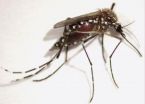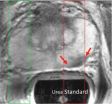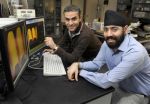(Press-News.org) LIVERMORE, Calif. - Arsenic - an element that triggers death for most Earthly life forms - is actually allowing for a bacterium to thrive and reproduce.
In a study that may prompt the rewriting of textbooks, a team of astrobiologists and chemists has found the first known living organism that can use arsenic in place of phosphorus in its major macromolecules. The new findings, published in the Dec. 2 Science Express, could redefine origins of life research and alter the way we describe life as we know it.
Oxygen, carbon, hydrogen, nitrogen, sulfur and phosphorous are the six basic building blocks of life on Earth. These elements make up nucleic acids, proteins and lipids - the bulk of living matter.
The new study by Lawrence Livermore National Laboratory and led by NASA and the U.S. Geological Survey has found that a bacterium isolated from Mono Lake may substitute arsenic for phosphorus to sustain its growth.
Mono Lake, located in eastern California, is an alkaline and hypersaline lake with high dissolved arsenic concentrations and is believed to have formed more than 760,000 years ago from neighboring volcanic eruptions.
Felisa Wolfe-Simon, a NASA astrobiology research fellow in residence at the USGS and the paper's lead author, has been studying possible arsenic based life forms at the lake for some time. Using samples from Mono Lake and a culture medium with reduced phosphorus levels, she showed that that a strain of Gamaproteobacteria can not only survive using arsenic but can grow as well.
"We know that some microbes can 'breathe' arsenic, but what we've found is a microbe doing something new - building parts of itself out of arsenic," Wolfe-Simon, said.
LLNL's Jennifer Pett-Ridge and Peter Weber were able to identify low concentrations of arsenic found in individual cells of bacteria and extracted DNA. NanoSIMS is a tool which allows precise, spatially explicit, elemental and isotopic analysis down to the 50-nanomenter scale; it also offers a range of advantages for sensitive and high-resolution measurements.
"It turned out the organism was able to tolerate these heavy metal concentrations (that are found in Mono Lake)," Pett-Ridge said. "Arsenic is right below phosphorous on the periodic table and it may have found a way to substitute arsenic for phosphorous in its biological makeup."
Cultures of the Mono Lake samples produced flourishing colonies of the bacterium cells, as expected, when fed a steady supply of phosphorus, along with other necessities. When researchers removed the phosphorus and replaced it with arsenic, however, the microbes continued to grow. Subsequent analyses indicated that the arsenic was being used to produce the building blocks of new cells.
"The team hasn't yet established how the organism uses arsenic as a building block when it's a poison to most other life forms," Pett-Ridge said. "It could be an ancestral trait or a unique kind of metabolism. Or it could be that it lives in an environment where arsenic is very high and it found a niche to survive."
"This organisms' metabolic lifestyle suggests that life based on non-typical elements may be possible," Wolfe-Simon said. "This is important to scientists looking for clues to life on other planets."
NanoSIMS not only measures the elemental concentrations, but it also images them. It collects a picture of the image and identifies how much of a specific element is found in the sample. "We found that arsenic was higher in the cells than in the environment outside the cells," Pett-Ridge said.
"It's very difficult to make these measurements because the sample concentrations of arsenic are very low," she said. "But it's clear that the cells are incorporating arsenic into them. There are not a lot of organisms on the planet that can do this. "
The next step is to conduct protein biochemistry to find out if there are specific enzymes that help transport arsenic into the cells. Other collaborators include NASA Astrobiology Institute, Arizona State University, Duquesne University, Stanford Synchrotron Radiation Lightsource and BEYOND: Center for Fundamental Concepts in Science at Arizona State University.
###
The LLNL NanoSIMS facility began via a grant from the Department of Energy's Office of Science Genomes: GTL program.
Founded in 1952, Lawrence Livermore National Laboratory (www.llnl.gov) is a national security laboratory that develops science and engineering technology and provides innovative solutions to our nation's most important challenges. Lawrence Livermore National Laboratory is managed by Lawrence Livermore National Security, LLC for the U.S. Department of Energy's National Nuclear Security Administration.
END
RIVERSIDE, Calif. – Each year, dengue fever infects as many as 100 million people while yellow fever is responsible for about 30,000 deaths worldwide. Both diseases are spread by infected female Aedes aegypti mosquitoes, which require vertebrate blood to produce eggs. The blood feeding and the egg development are tightly linked to how the mosquito transmits the disease-causing virus.
Now a team of entomologists at the University of California, Riverside has identified a microRNA (a short ribonucleic acid molecule) in female Aedes aegypti mosquitoes that when deactivated ...
Raw milk is consumed by an estimated 1-3 percent of the United States population. Raw milk and raw cheeses are responsible for almost 70 percent of reported dairy outbreaks. On July 16, 2008, the Connecticut Department of Public Health identified two unrelated children who had experienced hemolytic uremic syndrome after consuming raw milk from the same farm. The authors investigated the situation further and found more cases of people affected by raw milk from the same farm. The details of their study are chronicled in the Dec. 15 issue of Clinical Infectious Diseases, ...
A fast test to diagnose fatal brain conditions such as mad cow disease in cattle and Creutzfeldt-Jakob disease in humans could be on the horizon, according to a new study from National Institutes of Health scientists. Researchers at NIH's National Institute of Allergy and Infectious Diseases (NIAID) have developed a highly sensitive and rapid new method to detect and measure infectious agents called prions that cause these diseases.
"Although relatively rare in humans and other animals, prion diseases are devastating to those infected and can have huge economic impacts," ...
The research was led by Dr. Matthew Ellinwood, a veterinarian and animal science professor at Iowa State University, in collaboration with Dr. Patricia Dickson at the Harbor-UCLA Medical Center, with colleagues at the Iowa State College of Veterinary Medicine, the University of Tennessee, St. Louis University and the University of Pennsylvania. Their work was published in the AAAS journal Science Translational Medicine.
The research focused on a disorder called mucopolysaccharidosis type I, or MPS I, which is caused by the lack of a key enzyme that breaks down substances ...
November 30, 2010 -- Despite the existence of effective programs for treating alcohol dependencies and disorders, less than a quarter of people who are diagnosed actually seek treatment. In a recent study by Columbia University's Mailman School of Public Health researchers report that people diagnosed with alcoholism at some point in their lifetime were more than 60% less likely to seek treatment if they believed they would be stigmatized once their status is known.
This is the first study to address the underuse of alcohol services specifically with regard to alcohol-related ...
###
Gold, L., et al. (2010). “Aptamer-based multiplexed proteomic technology for biomarker discovery,” PLoS One. Available online at http://dx.plos.org/10.1371/journal.pone.0015004
Ostroff, R. et al. (2010). “Unlocking biomarker discovery: Large scale application of aptamer proteomic technology for early detection of lung cancer.” PLoS One. Available online at http://dx.plos.org/10.1371/journal.pone.0015003
About SomaLogic, Inc.
SomaLogic, Inc., is a privately held biomarker discovery and clinical proteomics company based in Boulder, Colorado. The company's mission ...
A UCSF research collaboration with GE Healthcare has produced the first results in humans of a new technology that promises to rapidly assess the presence and aggressiveness of prostate tumors in real time, by imaging the tumor's metabolism.
This is the first time researchers have used this technology to conduct real-time metabolic imaging in human patients and represents a revolutionary approach to assessing the precise outlines of a tumor, its response to treatment and how quickly it is growing.
Data on the first four patients are being presented today at the Radiology ...
AMES, Iowa – Researchers from Iowa State University and the Ames Laboratory have developed a process capable of producing a thin and uniform light-absorbing layer on textured substrates that improves the efficiency of polymer solar cells by increasing light absorption.
"Our technology efficiently utilizes the light trapping scheme," said Sumit Chaudhary, an Iowa State assistant professor of electrical and computer engineering and an associate of the U.S. Department of Energy's Ames Laboratory. "And so solar cell efficiency improved by 20 percent."
Details of the fabrication ...
(Santa Barbara, Calif.) –– A ballet dancer grasps her partner's hand to connect for a pas de deux. Later that night, in the dark, she reaches for her calf to massage a sore spot. Her brain is using different "maps" to plan for each of these movements, according to a new study at UC Santa Barbara.
In preparing for each of these reaching movements, the same part of the dancer's brain is activated, but it uses a different map to specify the action, according to the research. Planning to hold hands is based on her visual map of space. Her second plan, to reach for her calf, ...
DENVER (December 2, 2010) – Fresh water and reusable energy. Humans are on a constant hunt for a sustainable supply of both. Water purification requires a lot of energy, while utility companies need large amounts of water for energy production. Their goal is to find a low-energy-required treatment technology. Researchers from the University of Colorado Denver College of Engineering and Applied Science may have discovered an answer.
Last year, a study published in Environmental Science & Technology incorporated desalination into microbial fuel cells, a new technology ...


